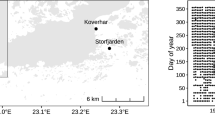Abstract
Confirming the results of previous regional studies on changes in first bloom dates (FBD) in China, this study provides evidence that complements conclusions drawn from studies of phenological changes in other dynamic climate systems in the Northern Hemisphere. Furthermore, increased occurrences of yearly second blooms (YSB) further reinforce results derived from other studies indicating a recent trend of generalized climate warming across China. Additionally, ascertaining changes in FBD and YSB against a recent background not only provides a hitherto poorly formulated autumnal equivalent to the well-studied shifts in FBD, but also formulates both spring and autumn flowering changes in recent years. Data in this study are derived from observations made from 1963 to 2006 by the Chinese Phenological Observation Network (CPON)—a nationwide system of monitoring stations that has made observations of over 173 species from across China since 1963. At each site, the mean value of each species’ annual deviation and spring mean surface temperatures were calculated. For each species, years and locations were also recorded for species in which second blooms (YSB) occurred. Of the 46 FBD samples, 31 showed advances from the mean, blooming earlier over the course of the study period. Notably, although only 8 of the 46 FBD samples showed significance levels of 0.1 or better, the average FBD did advance by 5.3 days. After the 1980s, the frequency of YSB occurrence remained steady, declining a little from the peak in the 1980s, but still exhibiting occurrences far more than were observed earlier. The data from this study clearly indicate that both the phenological advance of FBD in spring and the increased occurrence of YSB are consistent with climate warming.



Similar content being viewed by others
References
Chen X, Hu B, Yu R (2005) Spatial and temporal variation of phenological growing season and climate change impacts in temperate eastern China. Glob Change Biol 11:1118–1130
Chuine I, Beaubien EG (2001) Phenology is a major determinant of tree species range. Ecol Lett 4:500–510
Cleland EE, Chuine I, Menzel A, Mooney HA, Schwartz MD (2007) Shifting plant phenology in response to global change. Trends Ecol Evol 22:357–365
Doi H, Takahashi M (2008) Latitudinal patterns in the phenological responses of leaf colouring and leaf fall to climate change in Japan. Glob Ecol Biogeogr 17:556–561
Doi H, Takahashi M, Katano I (2010) Genetic diversity increases regional variation in phenological dates in response to climate change. Glob Change Biol 16:373–379
Fitter AH, Fitter RSR (2002) Rapid changes in flowering time in British plants. Science 296:1689–1691
Gange AC, Gange EG, Sparks TH, Boddy L (2007) Rapid and recent changes in fungal fruiting patterns. Science 316:71
Ibáñez I, Primack RB, Miller-Rushing AJ, Ellwood E, Higuchi H, Lee SD, Kobori H, Silander JA (2010) Forecasting phenology under global warming. Philos Trans R Soc B Biol Sci 365:3247–3260
Intergovernmental Panel on Climate Change (IPCC) (2007) Climate change 2007: the physical science basis. Cambridge University Press, New York
Li RP, Zhou GS, Guo CM et al (2008) Phenology characteristics of Ulmus pumila, its simulation from 1981 to 2005 in Northeast China (in Chinese). J Meteorol Environ 24:20–24
Li HM, Ma YS, Wang YL (2010) Influences of climate warming on plant phenology in Qinghai Plateau (in Chinese). J Appl Meteorol Sci 21:200–505
Luterbacher J, Liniger MA, Menzel A, Estrella N, Della-Marta PM, Pfister C, Rutishauser T, Xoplaki E (2007) Exceptional European warmth of autumn 2006 and winter 2007: historical context, the underlying dynamics, and its phenological impacts. Geophys Res Lett 34:L12704
Menzel A, Sparks TH, Estrella N, Koch E, Aasa A, Ahas R, Alm-Kubler K, Bissolli P, Braslavska OG, Briede A, Chmielewski FM, Crepinsek Z, Curnel Y, Dahl A, Defila C, Donnelly A, Filella Y, Jatczak K, Mage F, Mestre A, Nordli O, Penuelas J, Pirinen P, Remisova V, Scheifinger H, Striz M, Susnik A, Van Vliet AJH, Wielgolaski F-E, Zach S, Zust ANA (2006) European phenological response to climate change matches the warming pattern. Glob Change Biol 12:1969–1976
National council on climate change in China (2007) China’s National Assessment Report on Climate Change (in Chinese). Science Press, Beijing
Piao S, Ciais P, Friedlingstein P et al (2008) Net carbon dioxide losses of northern ecosystems in response to autumn warming. Nature 451:49–52
Schwartz MD, Chen X (2002) Examining the onset of spring in China. Clim Res 21:157–164
Schwartz MD, Reiter BE (2000) Changes in North American spring. Int J Climatol 20:929–932
Schwartz MD, Ahas R, Aasa A (2006) Onset of spring starting earlier across the Northern Hemisphere. Glob Change Biol 12:343–351
Wan M, Liu X (1979) China’s national phenological observational criterion (in Chinese). Science Press, Beijing
Zhang F, Jiang A (1996) A review of studies on the phenology in China. Phenol Seas 1:71–78
Zheng J, Ge Q, Hao Z (2002) Impacts of climate warming on plants phenophases in China for the last 40 years. Chin Sci Bull 47:1826–1831
Zheng JY, Ge QS, Hao ZX, Wang WC (2006) Spring phenophases in recent decades over eastern China and its possible link to climate changes. Clim Change 77:449–462
Acknowledgments
We would very much like to thank Gregory Pierce for his efforts in helping composing and editing the English language presentation of this paper. This research project was supported by National Natural Science Foundation of China (NSFC, Project No.: 41030101, 40625002, and 40871033), and project of Institute of Geographical Sciences and Natural Resources Research, Chinese Academy of Sciences.
Author information
Authors and Affiliations
Corresponding author
Electronic supplementary material
Below is the link to the electronic supplementary material.
About this article
Cite this article
Ge, Q., Dai, J., Zheng, J. et al. Advances in first bloom dates and increased occurrences of yearly second blooms in eastern China since the 1960s: further phenological evidence of climate warming. Ecol Res 26, 713–723 (2011). https://doi.org/10.1007/s11284-011-0830-7
Received:
Accepted:
Published:
Issue Date:
DOI: https://doi.org/10.1007/s11284-011-0830-7




